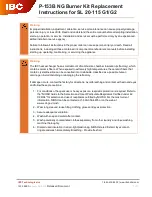
7.1
USING THE BOILER
7.1.1
GETTING TO KNOW THE CONTROL PANEL
(Fig. 21)
Before doing any work on the boiler, switch off the power
at the mains switch installed in the boiler room by the
electrician.
On the control panel, switch off the ON/OFF switch.
(item 2, Fig. 21)
1 - Control thermostat 60 to 90° C
(item 1, Fig. 21)
Central heating systems are generally designed to operate at 80° C
maximum. If they are operated at a lower temperature, a 3-way mixer
valve installed on the heating flow pipe
(see Fig. 3, page 3)
allows the
temperature to be set manually or, if you decide to install a regulator
(§ 2.2.4)
, automatically.
We recommend you set the thermostat to the maximum values to get
the best from the domestic hot water system.
The water stored in the domestic hot water tank in the boiler can be at
a very high temperature.
In all cases, install the thermostatic mixer
(Fig. 5b, page 4)
on the domes-
tic hot water flow pipe which must not exceed 60° C.
A blender or mixing valve is recommended at each point of use.
2 - ON/OFF switch
(item 2, Fig. 21)
This must be used to switch off the boiler before working on it.
3 - Summer/winter selector
(item 3, Fig. 21)
“Winter” position: activates both the hot water and central heating func-
tions. “Summer” position: the room thermostat or regulator
(§ 2.2.4)
is
switched off. The heating circulator is also switched off. Only the
domestic hot water function is provided. You can lower the temperature
on the thermostat (1) to save energy. If there is not enough hot water,
we recommend setting the thermostat (1) to its maximum value.
When the next heating season begins, simply select “Winter” to
reactivate the heating system.
4 - Thermometer
(item 4, Fig. 21)
Reads the temperature of the boiler primary circuit (central heating)
directly.
5 - Regulator
(item 5, Fig. 21)
See the user instructions enclosed if you have chosen this option.
7.1.2
HEATING SYSTEM GAUGE PRESSURE
Your system is fitted with a heating safety valve set to 3 bar, with a
pressure gauge.
Ensure that the water in the system is always pressurised. When cold,
and the air in the system has been vented, the pressure gauge must
show a pressure between 0.5 and 1.5 bar, depending on the height of
the building (1 bar = 5m / 1.5 bar = 10 m and 2 bar = 15 m).
To add water, open the filling valve
(Fig. 2 and 3 page 3)
. Close the valve
after filling. Vent the air in the system to get an accurate water
pressure reading.
7.1.3
SAFETY VALVE
(central heating)
(item 2, Fig. 3, page 3)
The drain pipe to waste water system drain must
be iaw current regulations.
In the event of a fault after this short trial, inform the
installing engineer.
7.1.4
SAFETY UNIT
(domestic hot water)
(item 1, Fig. 5a and 5b, page 4)
A monthly inspection is recommended.
Lift the lever on the emptying device for a few seconds to ensure that
the safety valve is working properly.
The drain pipe to waste water system drain must
be iaw current regulations.
In the event of a fault after this short trial, inform the
installing engineer.
7
USER GUIDE
Fig. 21: Control panel
2 4
1
3
5
12
































